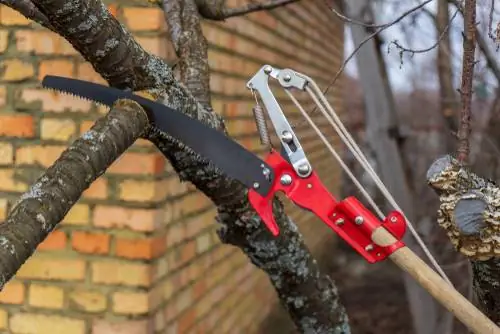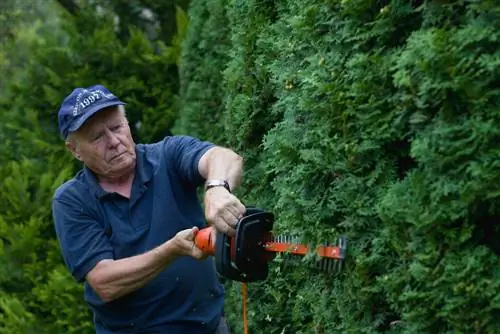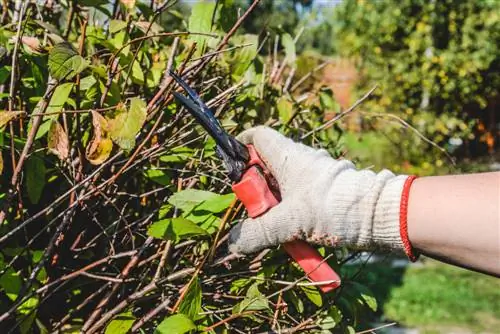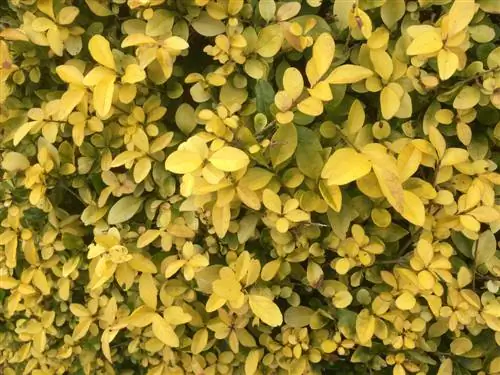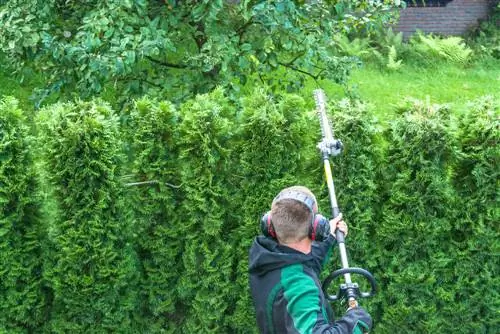- Author admin [email protected].
- Public 2023-12-16 16:46.
- Last modified 2025-06-01 06:02.
Fast growth, robust pruning tolerance and wintergreen foliage make privet the ideal hedge plant. Common privet (Ligustrum vulgare) is a native wild species that is well hardy and, with the variety 'Atrovirens', gives us the undisputed favorite for the perfect privet hedge. Oval-leaved privet (Ligustrum ovalifolium) impresses with the most beautiful foliage for formal hedges in mild winter locations. In this tutorial you will learn everything you need to know about caring for a privet hedge.

When should I cut the privet hedge?
Cut the privet hedge twice a year. The perfect cut occurs in February and August. The optimal time for topiary is in February. Then you can also remove the dead wood. The hedges grow quickly and are easy to trim.
When and how do you cut? - Types of cuts and dates in brief
In creative garden design, the privet hedge has emerged as a premium solution for representative fencing. In all sunny to shady locations with normal garden soil, the leafy bushes form a decorative room divider, flank the entrance gate as a green wall or are useful as a privacy screen. Annual pruning care ensures that the hedge grows beautifully dense and bushy. If you note the following types of cuts and dates on the care plan, the privet hedge will become a successful horticultural project:
| Cut style | Target | Appointment option I | Appointment option II | Appointment option III |
|---|---|---|---|---|
| Plant cutting | dense branching at the base | after planting | the following spring (February) | none |
| Build-up cut | compact growth and dense foliage | February to early March | End of June to mid-July | Mid to late August |
| Topiary | well-groomed appearance | February to early March | End of June to mid-July | Mid to late August |
| Rejuvenation cut | revitalize old privet hedge | November to February | none | none |
| Preservation cut bee pasture | Preserve vitality and flowering ability | February to early March | none | none |
Modern research has redefined the best time for hedge trimming. For a long time, St. John's Day (June 24th) was considered the ideal date for central pruning care on deciduous and coniferous hedges. Trials conducted by the Saxon State Horticultural Institute over several years have demonstrated the benefits of pruning in February. Your privet hedge will grow denser and more compact when you pick up the hedge trimmer for the first timemid to late February. End of Juneand mid toEnd of August two time windows open for light care cuts that focus on this year's growth.
Plant pruning instructions - start to the perfect privet hedge
You can plant a privet hedge made from inexpensive, bare-root products from October to March. The young plants usually have a strong central shoot and several weaker side branches. A planting cut aims at better branching in the lower area. Inexperienced home gardeners have serious scruples about this radical measure, because the cuttings were also paid for. If you skip pruning, you will be left with a bare hedge base in the long run. How to do a skillful cut on the day of planting:
- Stretch cords along the freshly planted privet hedge as a guide
- Prune young bushes by half on all sides
- Side branches inTrapezoid shape intersect with narrow crown and wider base
You should also rely on theplant cutting effectif you usepotwarefor your new privet hedge. On the better-branched young bushes in the container, pruning can be reduced toone third of the length. The weaker the side shoots, the stronger the cutting volume. In this early phase of pruning care, the trapezoid shape that will become so important later is at least hinted at. If a wide hedge base tapers towards the crown, the upper branches cannot shade the lower shoots.
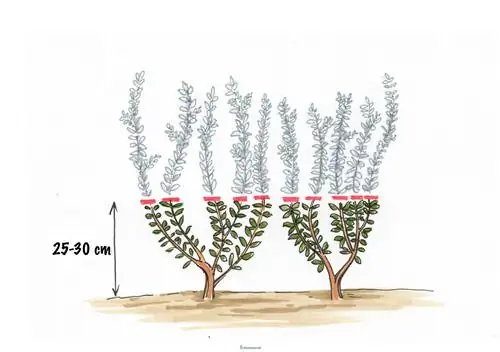
A vigorous pruning after planting stimulates the branching. Cut back all shoots by half.
Background
Juice jam allows the shoots to sprout
The great importance of plant pruning for the perfect privet hedge is based on a close connection between sap pressure and growth. In a privet, the juices generally strive upwards with important nutrients in their luggage. The tip bud receives the greatest sap pressure so that it grows towards the light as quickly as possible. The deeper a bud is positioned, the weaker the sap pressure and the resulting growth. The law applies equally to a shrub as a whole and to each individual shoot. If you cut off the top buds of the shoots after planting, the remaining buds benefit from the increased sap pressure and sprout vigorously. The more buds are removed, the stronger the sprouting from the remaining eyes.
Pruning technique on buds perfects the plant cut
For an exemplaryplant pruningwe recommend a clean, freshly sharpenedOne-handed secateursIn this phase of pruning care, manual two-handed and motorized hedge trimmers are far too large. It is up to your individual assessment whether you use bypass or anvil scissors. Correct cutting is more important for exemplary planting pruning. This is how it works:
- Look for an opposite pair of leaves or buds on the respective shoot
- Place the scissors a few millimeters slightly diagonally above the selected cutting point
- Do not cut into the leaves or buds and do not leave a stub larger than 5 millimeters
Professional pruning undoubtedly takes more time than if you shorten all young shoots briskly and imprecisely. If you follow the recommendedcutting technique on buds, the additional effort will result in vital shoots at the base of the plant with a lasting effect, as the growth law of top promotion teaches us. At the same time, there are no long shoot stubs above the interfaces, which dry out and serve as a target for pathogens.
Build-up cutting instructions - step by step to create a magnificent hedge
In the first few years, pruning of a privet hedge is characterized by a gradual structure. On the way to the desired final height, the height growth is intentionally throttled for an optimaldistribution of the sap flow to all branches and buds. Pruning twice a year is recommended for weaker growing privet species. Strong-growing common privet and its varieties benefit from pruning three times during the development phase. How to grow a densely branched and richly leafy privet hedge:
- Stretch cords along the hedge as a guide for the advantageous trapezoid shape
- Include the hedge crown, side surfaces and flanks in the cut
- Cut so that 10 centimeters remain from the previous growth
The image below illustrates the step-by-step pruning of a privet hedge. Undoubtedly, the recommended approach requires years of patience. Every time you cut back, it is important to slow down the sap pressure and force it into the side shoots, which are naturally criminally neglected in uncut bushes. By directing the sap flow into these shrub regions, your privet hedge thrives as an opaque green wall.
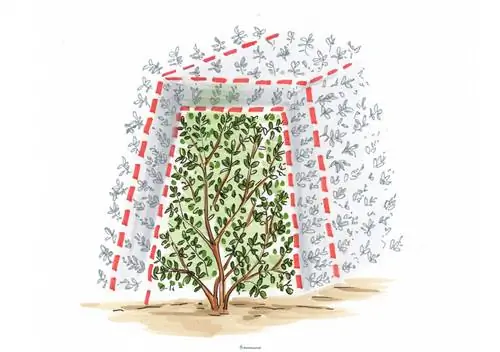
A vigorous pruning after planting stimulates the branching. Cut back all shoots by half.
Topiary instructions - this is how accurate hedge trimming works
When the final height is reached, the pruning care results in a regular topiary. The main date is in February, because at this time pruning can be carried out to any extent desired, including clearing out dead wood. Optionally, cut back the current growth on your privet hedge on St. John's Day and at the end of August for an accurate appearance for the rest of the year. From the beginning of September onwards, no pruning should be carried out so that privet branches mature before winter. How to do it right:
- To maintain a conical hedge shape, tension cords or set up wooden slats
- Cut back the hedge crown at the beginning, if necessary from a stable, stable ladder
- Crop hedge sides and flanks either from bottom to top or vice versa
- In February, also thin out dead wood and inward-facing shoots using scissors or a saw
When cutting the sides and sides of the hedge, choose a position that gives you a view of the uncut foliage and provides orientation aids. You can achieve a smooth cut without dents with an electric hedge trimmer, which you move with your arms stretched out from your shoulders, parallel to the surface. Trim the hedge crown with slight pivoting movements from the back. Bent arms leave a more uneven cut.
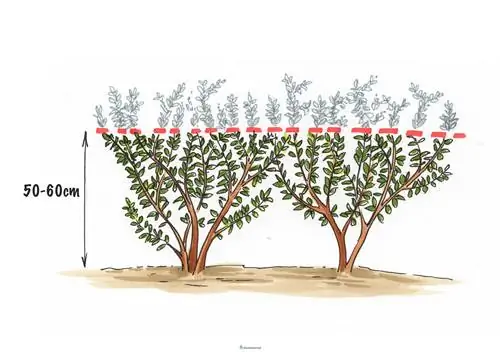
Cut your hedge into shape in spring and summer. Strong-growing privet varieties remain beautiful well into winter after a final topiary cut in August.
Excursus
Cut with muscle power or machine power?
With 5 to 6 centimeter long leaves, privet is in the lower middle range of popular hedge shrubs in terms of foliage size. The adverse effects of machine-operated hedge trimmers, such as when cutting cherry laurel, are not to be feared on a privet hedge. Privet leaves are small enough not to be caught between the knife bars and shredded. Furthermore, the extremely flexible shoots make cutting with an automatic hedge trimmer child's play. For cutting a large hedge more than 10 meters long, the motorized hedge trimmer is effective, energy-saving and time-saving. You can trim smaller privet hedges either by hand or using an electric hedge trimmer.
Rejuvenation cutting instructions - this is how green restoration works
An old, aging privet hedge won't mind a radical rejuvenation cut. On the contrary, vigorous pruning is rewarded with vital growth of young shoots. The floral masterpiece is successful because privet has numerous sleeping eyes. The dormant buds are rarely visible to the naked eye and act as an iron reserve for lost plant parts. By placing a privet hedge on the cane, you activate sleeping eyes and revitalize the shrubs. This is how it works:
- The best time is a frost-free, overcast day in late winter between January and the end of February
- Examine the privet hedge carefully for overwintering animals and reschedule the appointment if necessary
- At the beginning, cut or saw off all dead shoots at the base
- Cut back remaining branches by half to two thirds
Following a rejuvenation cut, fertilize the hedge bushes with three liters of compost and 100 grams of horn shavings per square meter. Just in time for the beginning of the growing season, vigorous growth begins, which you accompany with a multi-year pruning.
Background
Federal Nature Conservation Act has the final say on cutting times
Since the end of the 1990s, the situation of our 248 native breeding bird species has deteriorated dramatically. Songbirds that were previously widespread, such as tree pipits and goldfinches, are now under immediate threat. With a view to the impending “silent spring”, the Federal Nature Conservation Act sets out strict regulations regarding tree pruning. A radical cut, such as putting on the cane, rejuvenating or thinning out, is permitted from October 1st to February 28th. With the start of the breeding season on March 1st, a summer grace period begins, which prohibits pruning of bushes and hedges until September 30th. Light maintenance pruning is permitted provided that it can be ruled out that nesting birds will be disturbed by the measures. Anyone who fails to comply will face a hefty fine of up to 50,000 euros.
Privet hedge rarely cut as a bee pasture
Privet bushes are not limited to a life as a strictly formal hedge. Their pretty, white flower spikes are a popular destination forbees and bumblebeesin early summerIn general, there is a lot of activity in the dense, flexible branches, becausebreeding birdslike to build their nests in the privet. When fertilized flowers turn into black berries in the fall, the feathered residents have avaluable food source right in front of their beaks. The privet hedge only fulfills its role as an ecological gem if the gardener practices careful pruning care.
A privet bush blooms on its annual shoots in June and July. The best time for maintenance pruning is in February. Pruning care includes thinning out dead or unfavorably positioned shoots. Severe pruning could destroy a large proportion of the buds that have already formed. The following overview summarizes the most important conditions for cutting a privet hedge as a bee pasture:
- Pruning the plant by half initiates dense branching
- Ideally, build up every hedge bush with 7 to 12 ground shoots as a scaffold
- Remove remaining ground shoots at the base
- Thing out a free-growing privet hedge every 3 to 5 years
- Branches that are too long or heavily branched indicate a young side shoot in the lower branch area
- If necessary, cut back lanky long shoots by a third in June or August
- Cut off branches that lean towards the ground and root there at the base
Ground shoots of a privet bush remain vital and willing to bloom for 5 to 8 years. Write down a cut in the care program every few years and let thenatural growth happen. It is advantageous if you combine maintenance pruning with replacing 2 to 3 of the oldest scaffold shoots with young ground shoots. In this way, you subject a freely growing privet hedge to continuous rejuvenation, which saves you from radically uprooting it.
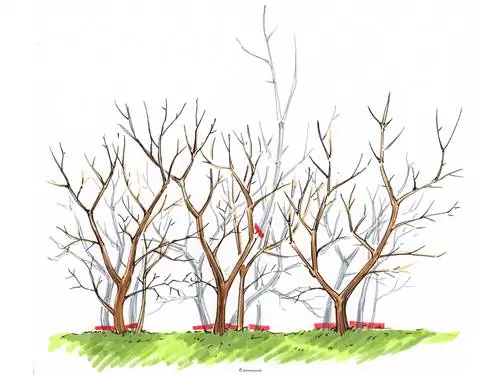
If the focus is on the abundance of flowers on a privet hedge, trim more conservatively than with a formal hedge. Thin out dead wood and weak shoots every 3 to 5 years. If branches are too long, shorten them so that a slight trapezoidal shape is maintained.
Frequently asked questions
Are privet bushes poisonous?
The Federal Ministry for the Environment and Nature Conservation regularly publishes an official list of poisonous plants in the Federal Gazette. All plants that can cause moderate to severe poisoning after contact are listed. Privet is not included on this list. However, eating berries can cause nausea and vomiting. Sensitive gardeners sometimes complain of itchy eczema, known as privet eczema, when their skin comes into contact with the plant sap. Regular topiary cuts prevent a privet hedge from flowering and fruiting. There is therefore nothing wrong with cultivation in the family garden. Wear gloves and long-sleeved clothing when cutting to prevent contact with the slightly toxic juice.
I would like to plant a privet hedge as a privacy screen. How big should the distance to the neighboring property be?
The first question that should be clarified is how high the hedge should ultimately be. A privet hedge with a height of 200 centimeters in the recommended trapezoid shape offers reliable privacy protection. A width of 80 to 100 centimeters must be taken into account in the lower area. If your neighbor allows hedge trimming from his property, the legal distance is 50 to 60 centimeters (more or less depending on the federal state). If you are forced to cut the side of the hedge facing the neighboring property from your garden, add a further 80 to 100 centimeters of distance so that you can maneuver unhindered with the hedge trimmer.
What does “bare root product” mean when buying privet for hedge planting?
Bare-rooted trees do not have a solid ball of soil. Tree nurseries offer the trees at the best planting time from the beginning of October to the end of April. Due to their low weight and uncomplicated processing, bare-root privet can be offered more cost-effectively than potted or container plants. In contrast to trees with soil balls, you cannot store bare-rooted products for a long time. In addition, plant pruning is strongly recommended in order to compensate for the loss of root mass due to clearing.
I learned at the garden center that oval-leaved privet cannot tolerate severe frost. My garden is in a harsh winter region with temperatures down to 2 digits below zero. Do I have to do without a privet hedge now?
If the thermometer falls significantly below -10 degrees Celsius in winter, Ligustrum ovalifolium loses its leaves and most of the shoots freeze back. Although the bushes do not die completely, they noticeably lose their beauty. It is better to use the frost-hardy variety 'Atrovirens' for the privet hedge. The local wild species was the inspiration here and guaranteed reliable winter hardiness without compromises. In the 2-digit minus range the leaves fall off. Just in time for the beginning of spring, fresh leaves sprout on the undamaged shoots.
There is an 8-year-old privet hedge in our garden in the Rhineland. Every year we ask ourselves when the hedge should be trimmed at the latest. Stronger pruning must be completed by the end of February due to the beginning of the breeding season. Will it harm our privet hedge if it freezes again in March or April?
It doesn't hurt a privet hedge if it gets another strong frost after pruning in February. This applies primarily to common privet (Ligustrum vulgare) and varieties derived from it. Although oval-leaved privet is somewhat more sensitive to frost, it can tolerate being cut in February without any damage. In the Rhineland, the thermometer generally does not fall so low in March and April that frost damage could occur.
The 3 most common cutting mistakes
A privet hedge that is far too loose and bare at the base and inside is the result of incorrect pruning care. The following table presents the 3 most common cutting errors with tips for effective prevention:
| Cutting errors | malicious image | Prevention |
|---|---|---|
| no pruning carried out | sparse branching at the base of the hedge | cut all shoots back by half after planting |
| rectangular hedge shape | bare hedge from below and inside | Cut privet hedge in a conical shape |
| Letting the privet hedge grow too fast | loose branching, little privacy | gradual construction in 10 cm increments |

Tip
A young privet hedge does not yet fulfill its privacy function. To ensure that you are still protected from prying eyes during the transition period, you should install reed mats or a fence. You can build a wooden privacy fence yourself with a little craftsmanship. Alternatively, set up a chain link fence and plant it with annual climbing plants until your privet hedge has reached the desired final height.


